Japanese vs Korean language.
Are they similar?
Are they different?
Which one is easier to learn?
And why do Japanese and Korean have similar words? All of these questions — and more — will be answered in this Japanese vs Korean language guide. This guide is split up into 4 parts.
- Overview of Japanese and Korean
- Similarities
- Differences
- Which is easier to learn?
So, let’s go.
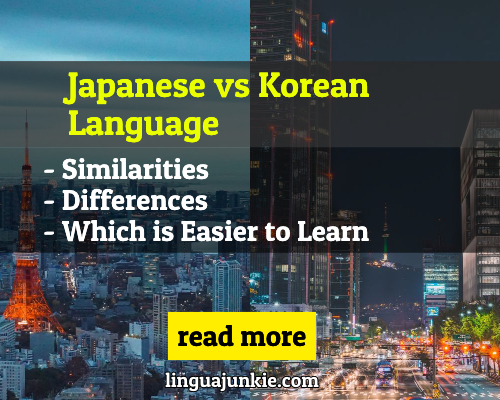
1) Overview of Japanese and Korean
First, Japanese…
The Japanese language has been historically influenced by Chinese and, more recently, western languages. Japanese uses three different types of writing forms: hiragana, katakana, and kanji. This can make it difficult for non-native speakers to learn the language since they need to learn three completely new writing systems.
And Korean?
Although there are many similarities between Korean and Japanese languages, most people believe that the similarities come more from the geographic closeness of the countries than the actual origins. like Japan, Korea also had a large influence from China in its language history. Korean uses a unique alphabet system called Hangul. Before Hangul was used, they also incorporated Chinese characters in their writing.
2) Similarities
A) Grammar
Japanese and Korean both have a similar grammar structure.
They generally follow a subject, object, and verb pattern in grammar.
Also, the use of particles in both languages is essential to describe various nuances of the verbs. Another interesting similarity is in the way that pronouns are often omitted from both languages and instead rely on context to determine the pronoun. Pronouns can be used in both languages to show different levels of closeness to the other person or how you want to be viewed by the other person.
B) Korean & Japanese Similar Words
There is a similar vocabulary in both languages.
Why? Because both languages have borrowed words from languages like Chinese or Portuguese. For example, the word for time is “jikan” in Japanese and “shikan” in Korean, which comes from Chinese influence. In addition, words like bread come from Portuguese influence. Bread is “ppang” in Korean and “pan” in Japanese.
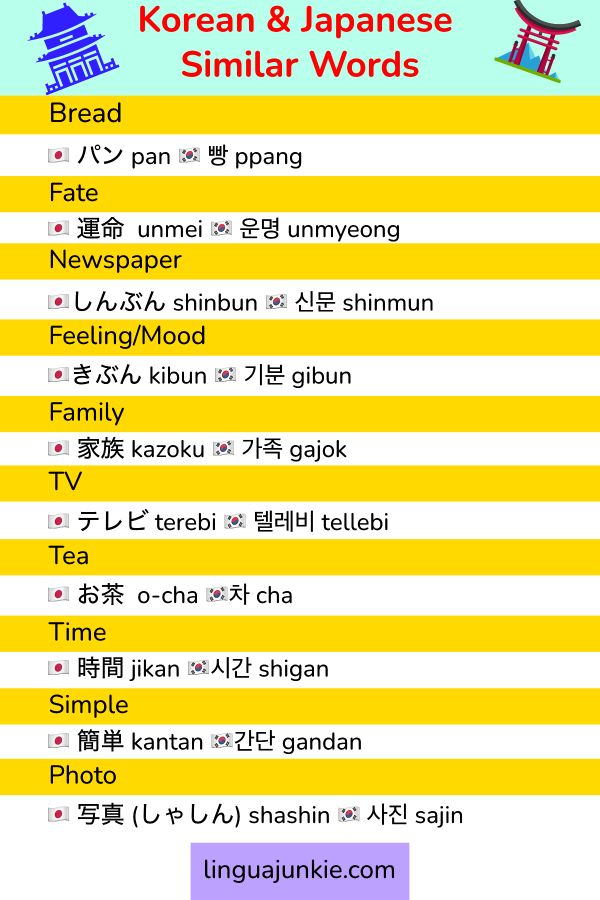 C) Chinese Influence
C) Chinese Influence
Japanese and Korean are both heavily influenced by Chinese.
The influence mainly comes in the form of borrowed words. Since the Japanese still uses Chinese characters, the borrowed words can be more obvious.
However, the Korean language also borrowed many words from Chinese. This is because Korean writing also used Chinese characters before the Hangul alphabet became the dominant writing system.
D) Phonetic language
In both Japanese and Korean, the language is phonetic.
This means that there is no tonal system that would drastically change the meaning of the words like in Chinese and Vietnamese.
Both languages use a straightforward combination of vowels and consonants to form words. In Japanese, when written in hiragana or katakana, the words are read the way it looks. In Korean, the hangul alphabet also shows how the words should be pronounced.
3) Differences
A. Korean vs Japanese Writing
One of the main differences between Korean and Japanese is the writing style.
In Korean, there is only one writing system called Hangul (Korean alphabet). Once you learn it, you can pretty much read and write in Korean.
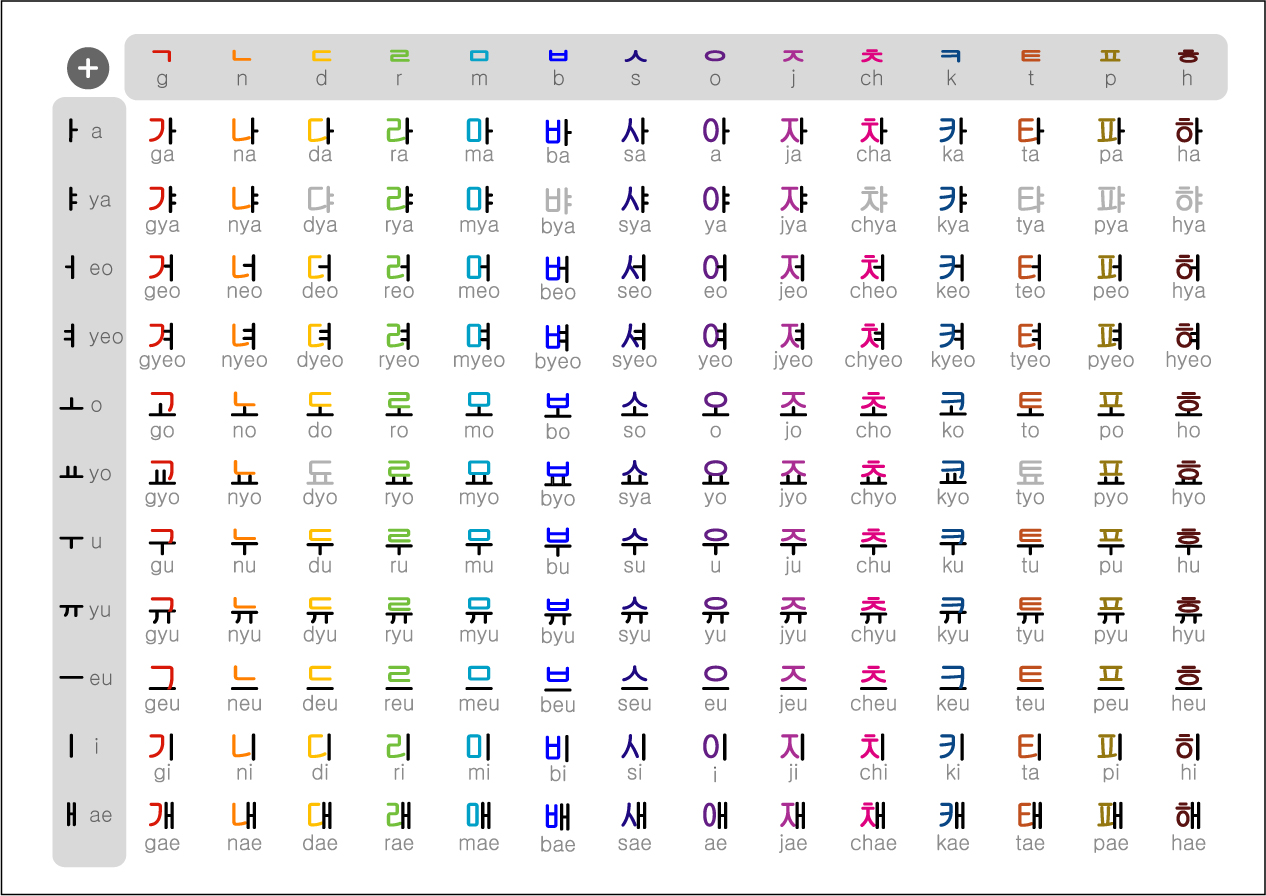
And the Japanese alphabet?
Well, Japanese uses three… different writing systems, not counting romaji.
1. Hiragana is used to fill in particles and areas where the kanji is not sufficient.
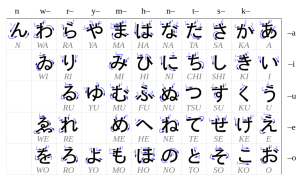
2; Katakana is used for foreign borrowed words.
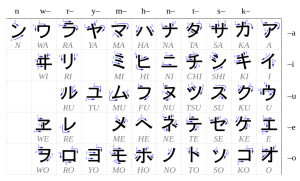
3. Kanji is a Chinese writing system that can have multiple ways to read each character. The kanji can be difficult because it is not predictable in terms of how to read the characters. You simply have to memorize which words correspond to the characters.
- I eat sushi.
- Hiragana version: わたしはすしをたべます。
- Version with Kanji: 私は寿司を食べます。

Three writing systems sounds like a lot but Hiragana and Katakana are very manageable. It’s the Kanji that you’ll sweat over.
B) Pronunciation
Another key difference between the two languages is pronunciation.
Japanese has a relatively straightforward pronunciation. There are only five main Japanese vowels that you need to know how to pronounce.
Korean has ten vowels that you need to know. These vowels are not as intuitive or straightforward as Japanese. For example, they can have combined vowels like “eu” or “ya.” The increased number of vowels in Korean makes some words sound more similar to each other, and it can be hard to learn how to pronounce them in a way that differentiates the vowel sounds.
If you want to hear how Japanese and Korean sound like, play the audio lessons below.
Japanese
| 3 Minute Japanese Lesson #1 by JapanesePod101. Click for more fun audio lessons like this. |
Korean
| 3 Minute Korean Lesson #1 by KoreanClass101. Click for more fun audio lessons like this. |
C) Politeness
Both languages have polite forms in their speech but… the levels of politeness are different.
In Japanese, there are mainly three politeness levels: plain, polite, or formal. Plain forms of the language are used among friends and family. The polite form can be with strangers and those of higher social status than you. Formal can be used in business situations or when you have customers.
On the other hand, Korean has seven different types of speech styles with varying degrees of politeness. They can range from “very formally polite” for talking to royalty, to “casually impolite” for talking with family, friends, and children.
4. Which Should You Learn? Korean vs Japanese Difficulty
Now, you might be wondering…
“Should i learn Korean or Japanese?”
“Is Korean or Japanese easier to learn for an english speaker?”
Both languages are considered difficult to learn, especially for those coming from languages that use the Latin alphabet. The biggest hurdle can often be learning the writing style.
So, if you’re wondering if Korean or Japanese is easier to learn…
Korean is probably the easiest to learn writing because there is one phonetic alphabet system. In comparison, Japanese requires you to know around 1,000 to 2,000 Chinese characters to be able to read and write the language for daily use.
Either way, according to the Foreign Service Institute, both are in the most difficult category for English speakers to learn.
HOWEVER…. Do you care about that? Look, you clearly like one or both of these languages for whatever reason, right?
So, why not learn anyway? Even if they’re considered hard, there are MILLIONS and MILLIONS of people learning Japanese and Korean because they want to. They know it’s hard. And they do it anyway. For anime. For k-pop. For culture. For k-dramas. And they’re succeeding too… even though it takes some time to get good in these languages. So, why can’t you?
Now, back to you.
Which language will you learn?
Japanese? Korean? Both? One now, one later? Let me know by leaving me a comment-a-roo down below.
And if you are keen on learning Japanese or Korean, check out these audio lessons again. And go check out KoreanClass101 and JapanesePod101.
Japanese
| 3 Minute Japanese Lesson #1 by JapanesePod101. Click for more fun audio lessons like this. |
Korean
| 3 Minute Korean Lesson #1 by KoreanClass101. Click for more fun audio lessons like this. |
Or, if you just want to start with the alphabet basics… check out out these FREE Alphabet Workbooks from JapanesePod101 and KoreanClass101.
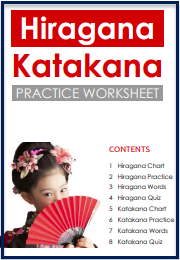 Click here to download the FREE Hiragana/Katakana Alphabet Workbook. (JAPANESE) Click here to download the FREE Hiragana/Katakana Alphabet Workbook. (JAPANESE) |  Click here to download the FREE Hangul Alphabet Workbook. (KOREAN) Click here to download the FREE Hangul Alphabet Workbook. (KOREAN) |
– The Main Junkie